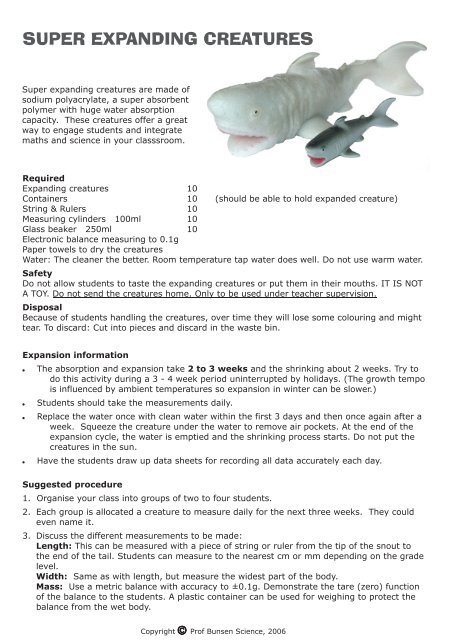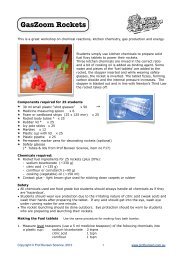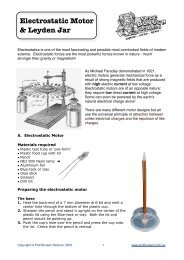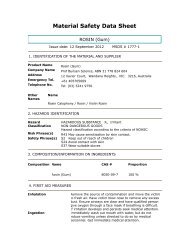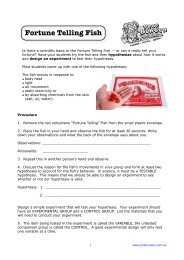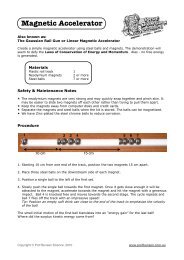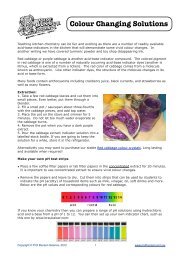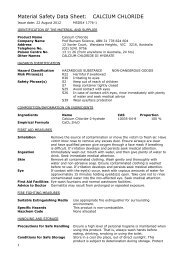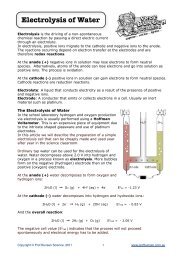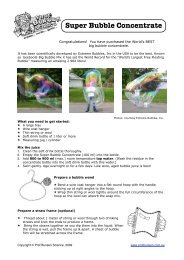Super Expanding Creatures - Prof Bunsen
Super Expanding Creatures - Prof Bunsen
Super Expanding Creatures - Prof Bunsen
Create successful ePaper yourself
Turn your PDF publications into a flip-book with our unique Google optimized e-Paper software.
SUPER EXPANDING CREATURES<strong>Super</strong> expanding creatures are made ofsodium polyacrylate, a super absorbentpolymer with huge water absorptioncapacity. These creatures offer a greatway to engage students and integratemaths and science in your classsroom.Required<strong>Expanding</strong> creatures 10Containers 10 (should be able to hold expanded creature)String & Rulers 10Measuring cylinders 100ml 10Glass beaker 250ml 10Electronic balance measuring to 0.1gPaper towels to dry the creaturesWater: The cleaner the better. Room temperature tap water does well. Do not use warm water.SafetyDo not allow students to taste the expanding creatures or put them in their mouths. IT IS NOTA TOY. Do not send the creatures home. Only to be used under teacher supervision.DisposalBecause of students handling the creatures, over time they will lose some colouring and mighttear. To discard: Cut into pieces and discard in the waste bin.Expansion informationThe absorption and expansion take 2 to 3 weeks and the shrinking about 2 weeks. Try todo this activity during a 3 - 4 week period uninterrupted by holidays. (The growth tempois influenced by ambient temperatures so expansion in winter can be slower.)Students should take the measurements daily.Replace the water once with clean water within the first 3 days and then once again after aweek. Squeeze the creature under the water to remove air pockets. At the end of theexpansion cycle, the water is emptied and the shrinking process starts. Do not put thecreatures in the sun.Have the students draw up data sheets for recording all data accurately each day.Suggested procedure1. Organise your class into groups of two to four students.2. Each group is allocated a creature to measure daily for the next three weeks. They couldeven name it.3. Discuss the different measurements to be made:Length: This can be measured with a piece of string or ruler from the tip of the snout tothe end of the tail. Students can measure to the nearest cm or mm depending on the gradelevel.Width: Same as with length, but measure the widest part of the body.Mass: Use a metric balance with accuracy to ±0.1g. Demonstrate the tare (zero) functionof the balance to the students. A plastic container can be used for weighing to protect thebalance from the wet body.Copyright <strong>Prof</strong> <strong>Bunsen</strong> Science, 2006
Volume: This is measured using the displaced water method. A glass beaker or measuringcylinder is filled to its brim with water. Students place the creature in the beaker, collectingthe spilled water in a container. The volume of the spilled water is then measured inmillilitres using a measuring cylinder. Make them repeat this 3 times and record allreadings.4. The first set of measurements is made before the creature is immersed in water.5. The creature is then placed in a container filled with enough water to cover the creature.6. The same daily routine is followed each day until around the 20th day when all water isemptied and the shrinking process recorded for the next 14 days.7. At the end of the project all collected data can be graphed using bar or line graphs and aprogram such as MS Excel. We have graphed our data below.ExplanationThe creature is made of sodium polyacrylate, a super absorbent polymer (SAP). It is one of only afew man-made polymers that are hydrophilic (water loving). The SAP has a high concentration of sodiumor potassium ions which attract water through a process known as osmosis. Osmosis is the passage ofwater through a semipermeable membrane to an area with a lower water concentration (or higher saltconcentration). It is a very important driving force in nature. The SAP turns into a gel as a result ofabsorbing the water. By sprinkling salt onto the gel, the reverse osmotic process is favoured. Waternow passes through the membrane to the outer higher salt concentration (Try this by sprinkling saltgenerously onto the tail.)Shark Growth800.0700.0600.0500.0400.0300.0Length in mmWidth in mmMass in g200.0100.00.01 3 5 7 9 11 13 15 17 19 21 23 25 27 29 31 33DaysAdditional investigationsStudents place creatures in water with different salt concentrations eg. distilled water, tap water, 1tsp., 2 tbs., 4 tbs salt in a glass of water. What influence does this have on the growth?Does hot or cold water influence a creature's growth?Another highly popular activity with students is the production of “ instant snow” a super absorbentpolymer that expands 40 times in volume trough an osmotic absorption process. You will find this underMolecules in our catalogue / online shop. (Instant <strong>Expanding</strong> Snow)Copyright <strong>Prof</strong> <strong>Bunsen</strong> Science, 2006www.profbunsen.com.au


